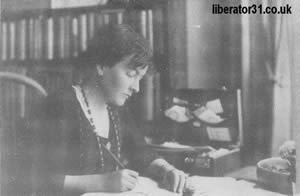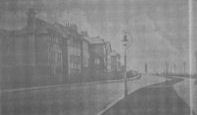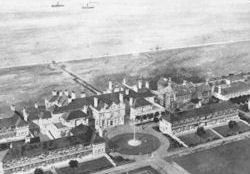The Leasowe Sanatorium For Crippled Children and Hospital for Tuberculosis, to give its full and original name, later became known as the Liverpool Open-Air Hospital, Leasowe, and finally Leasowe Hospital.
To tell the story of the hospital, one name above all stands out and that is Margaret Beavan (born 1877, died 1931). She was the driving force, admired by all, she was known affectionately as the 'Little Mother of Liverpool', also not quite as complimentary - the 'Mighty Atom' and 'Clever Beggar'. Even at school, she did not like to lose and though only small, she entered all sports with great determination. She later became Head Girl and even at this early age she was endeavouring to help the poor in some way. Her first effort was to cajole the other girls in joining her in giving a Christmas tree to the poor of the dockland. She eventually went on to Liverpool University. Whilst there, she joined the Kyrle Society, who were philanthropists, who gave money out of their own pockets to help the poor. Upon leaving University, she rented a small room in the middle of the slums, as an office. During this time she came to the notice of a Mr A V Paton (he was later knighted), who was a remarkable man who devoted all of his time to helping children and the West Kirby Convalescent Home for Children (the first of its kind in the country).
With his guidance, they started in 1891 the Invalid Children's Aid. It was built around a London model founded a few years earlier. It was mannered by volunteers who tried to help sick children to go to the country for convalescent. It was haphazard and disorganised affair. They literally picked children up off the streets. It was starting to get beyond the means of the Kyrle Society, so they had to look for help somewhere else, and in due course, they joined with the Crippled Childrens' Workshops that was doing well. This led to a name changing and a new start. So in January 1908, the Invalid Children's Association was founded. The name was to change again when in 1919 it became the Liverpool Child Welfare Association. Margaret Beavan was its chief from its inception in 1907 until her death in 1931. The Association's work covered a large area, although it started in Liverpool, its work stretched from Runcorn to Ellsemere Port to Bootle and Birkenhead, and the surrounding areas. By the 1970s, all its work had been taken over by the National Health Service and the Department of Health and Social Security. The Association still exists but only as a legal entity. It still owns its premises in Copperas Hill which was rented to the Women's Royal Volunteers Service, but is now closed.
Margaret Beavan became the first woman Lord Mayor of Liverpool in 1927/28. She also officiated at the break-through of the first Mersey Tunnel (the Queensway) in 1931. She caught a cold and developed pneumonia and died. She was also a Magistrate and spent all her life as a volunteer worker.
The first mention of a Sanatorium for T.B children occurred on the 16th December, 1911. At a Committee Meeting, after communication with the Medical Officer of Health and the Education Committee, it appeared that they were to receive a grant of up to 3/5th's of the capital cost. The next meeting held on 23rd January, 1912, Sir G. Newman of the Whithall Board of Education, indicated
that as far as he could see from the plans submitted, the Sanatorium would get approval from the Board; and as regards to capital expenditure, it would be prepared to make a grant of £70-£90 per bed and 50% of maintenance costs for all children sent by the Municipal. By this time, a site had been found in Leasowe. The Board of Education sent a number of staff down the next day to inspect the site.
At another meeting on the 13th February, 1913, it was confirmed that the site was acceptable. The deeds were drawn up and the Association was incorporated. Everything was set in motion - an appeal was sent to over 5,000 in Liverpool with regard to the Leasowe Sanatorium; a parliamentary list of donations had already reached £6,731; there were four sums of £1,000 by George Holt, Miss Holt of Holt Shipping Lines, Mr H Harrison of The Harrison Shipping Lines and Mr A V Paton in memory of his wife. Further donations from the Brocklebank family were received also many others soon swelled the coffers.
The next step was to purchase the land and this happened on the 17th April, 1913. The land was owned by the Webster family and farmed by the Beed family.
Under the heading 'Transaction with regard to Leasowe': it was reported that the contract had already been signed, the estate had been purchased - part of the money having been paid on signing, the balance to be completed when the Association's possession of the said property on 1st September, 1913 - the price being £3,600, 17th April, 1913. They also tried to purchase the land opposite on the shore side but the landowner, Mr. Sparks, wanted more then the Association could afford.
The Association agreed to renew the tenancy of these fields with Mr. Beed for three months, at the same rental he had paid before, namely £10 per annum. By the 14th August, 1913, the Committee asked for tenders from building firms, the winning bid came from Messrs Brown & Backhouse since theirs was the lowest tender.
An Executive Committee meeting was held the next day - 14th August, 1913, The Secretary reported that the tender by Messrs Brown & Backhouse had formally been accepted, namely £2, 500 for Blocks A and B hospital buildings, and £3,230 for Block C - in total £5,730. Messrs Brown & Backhouse had already commenced work on the 11th August, 1913. The work was completed on time and the first children were taken into Faith Block on 7th July, 1914. The Commemorative Stone was laid on 21st July, 1914. The total cost of the building the hospital was £180,000.
The first years running cost in 1947 (before the National Health Service took over) was £47,844 2s.0d. There was no effective cure for tuberculosis until the 1940s when a Ukraine scientist, Selman Waksman, working in the USA, discovered the drug Streptomycin. It was an antibiotic and stopped the tubercle bacillus from multiplying. Slowly Leasowe Hospital changed from being principally a children's T.B hospital to one for dealing with burns and skin grafts, and then arthritis until its closure in 1979. It was bought by the Wirral Christian Centre in 1981 and was used later as a Retirement Home and Handicap Centre. The buildings were later demolished and luxury apartments and houses were built on the site.
Reference
Moreton Wirral - A Pictorial History by Frank Biddle and Alan Fellowes
Featured sites
- Non Gamstop Casinos
- Casino Not On Gamstop
- UK Casinos Not On Gamstop
- Non Gamstop Casinos UK
- Sites Not On Gamstop
- Sites Not On Gamstop
- Casinos Not On Gamstop
- Casinos Not On Gamstop
- Casinos Not On Gamstop
- Non Gamstop Casino UK
- Casinos Not On Gamstop
- Non Gamstop Casino
- UK Online Casinos Not On Gamstop
- UK Online Casinos Not On Gamstop
- Non Gamstop Casinos
- Casino Sites Not On Gamstop
- Casinos Not On Gamstop
- Casinos Not On Gamstop
- Best Betting Sites
- Casinos Not On Gamstop
- Gambling Sites Not On Gamstop
- Betting Sites That Are Not On Gamstop
- Non Gamstop Casinos UK
- UK Online Casinos Not On Gamstop


